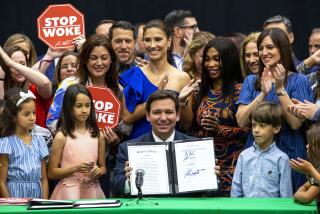Supreme Court takes middle ground on affirmative action
WASHINGTON — Defying expectations that it was on the brink of doing away with affirmative action in higher education, the Supreme Court upheld using race as a factor in admissions decisions Monday as long as the race-based policies were truly necessary to achieve diversity.
The 7-1 vote brought conservative and liberal justices together on a middle-ground approach that reaffirms the importance of racial and ethnic diversity on campus while pushing college officials to try “race-neutral” policies for enrolling more minority students.
The decision in the case from the University of Texas was written by Justice Anthony M. Kennedy. He was joined by Chief Justice John G. Roberts Jr. and Justices Samuel A. Alito Jr., Antonin Scalia, Clarence Thomas, Stephen G. Breyer and Sonia Sotomayor.
That outcome came as a relief to university officials and civil rights advocates. Since the justices agreed to hear the case last year, many had expected the conservative majority to use it as a vehicle to end affirmative action in education.
“The educational benefits of diversity are clear,” said Wade Henderson, president of the Leadership Conference on Civil and Human Rights. “The court’s decision reaffirms that it is in our national interest to expand opportunities for everyone.”
Critics of affirmative action said they were pleased the justices remained skeptical of the idea of treating applicants differently because of their race.
Edward Blum, the American Enterprise Institute fellow who led the challenge to the Texas policy, said the court had “established exceptionally high hurdles” for universities that wish to continue race-based admissions policies. “This decision begins the restoration of the original color-blind principles to our nation’s civil rights laws,” he said.
The justices did not rule on the constitutionality of the University of Texas admissions policy, which favored some minority applicants, or on whether the university had violated the rights of Abigail Fisher, a white applicant who was turned down in 2008 and who brought the original lawsuit.
Instead, the justices told the U.S. 5th Circuit Court of Appeals to take another look at the case and decide whether the Austin campus still needed to give a preference to some minority applicants. The justices noted that the state’s “top 10” law, which awards college admission to the top 10% of each high school’s graduates, has already led to an influx of Latino and black students.
Citing that improvement, Kennedy said it was no longer clear that the university needed to give an edge to black or Latino applicants to ensure a significant percentage of minorities on campus. The judges who review the Texas policy “must ultimately be satisfied that no workable race-neutral alternatives would produce the educational benefits of diversity,” he said in University of Texas vs. Fisher.
“If a nonracial approach” could work to bring about diversity, “then the university may not consider race,” he said.
Kennedy’s opinion won support from the conservative and liberal wings of the court, though Scalia and Thomas said they would have ended affirmative action if they could have.
The decision marked the first time that Roberts and Alito had endorsed the use of race as one factor in college admission decisions.
Justice Ruth Bader Ginsburg dissented alone, saying she would have upheld the Texas policy. Justice Elena Kagan took no part in the decision, since the case was under appeal when she served as U.S. solicitor general.
University of Texas President Bill Powers said he was encouraged by the ruling, noting the court had preserved precedents dating to 1978 that permit affirmative action. “Today’s ruling will have no impact on admissions decisions we have already made or any immediate impact on our holistic admissions policies,” Powers said.
Despite its progress in achieving diversity with the “top 10” law, the university’s leadership said that success relied on the continued segregation of many high schools. The “top 10” plan also left out too many talented minority students from integrated, highly competitive high schools, they said.
A leading liberal critic of affirmative action said he was pleased the court told college officials they should consider race-neutral policies to achieve diversity. Richard Kahlenberg, a scholar at the Century Foundation, said universities should give “a break to economically disadvantaged students of all races.”
Since the 1970s, the justices, like the American public, have remained divided over affirmative action. On the one hand, many liked the idea of the nation’s leading universities opening the doors of opportunity to qualified minority students. At the same time, others objected to giving an explicit preference to some applicants over others because of race and ethnicity. This seemed to conflict with the Constitution’s promise of “equal protection of the laws.”
That tension has remained. In 1978, the court by a 5-4 vote struck down a policy at UC Davis Medical School because it reserved 16 of 100 slots for minorities. This was a quota, the majority said. At the same time, Justice Lewis Powell’s controlling opinion said universities may consider a student’s race in order to achieve a diverse class.
Powell’s opinion became the governing rule, and his reference to diversity became the standard justification for affirmative action.
The Supreme Court revisited the issue in 2003, in a pair of cases from the University of Michigan. In one case, the justices struck down the undergraduate admissions policy at Ann Arbor because it awarded extra points to minority applicants. But in a 5-4 decision with an opinion written by Justice Sandra Day O’Connor, the court upheld the admissions policy at the law school because it evaluated students as individuals, but gave some weight to their race.
During that same period, while affirmative action was winning narrowly in the Supreme Court, it was losing when put before voters. California’s voters approved a measure in 1996 that prohibited state agencies, including universities, from discriminating against or “granting preferential treatment” to any individual because of race. Similar bans have been adopted in Washington, Michigan, Florida, Arizona, Nebraska, Oklahoma and New Hampshire.
Following the court’s 2003 ruling, the University of Texas decided to reintroduce an affirmative action policy that had been suspended in the 1990s after a loss in a lower court. That decision set the stage for Monday’s ruling.
[For the Record, 6:38 a.m. PST June 25: An earlier version of this story cited two 2003 cases involving the University of Michigan’s medical school. The cases actually originated from the university’s law school.]
More to Read
Start your day right
Sign up for Essential California for news, features and recommendations from the L.A. Times and beyond in your inbox six days a week.
You may occasionally receive promotional content from the Los Angeles Times.







